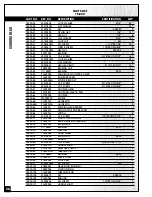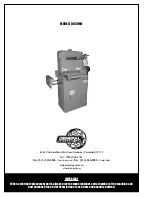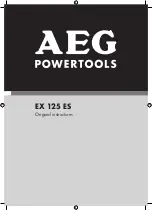
MAKE SURE TO HAVE ON SAFETY GLASSES AS WELL AS HEARING AND RESPIRATORY PROTECTION AT ALL TIMES WHEN USING THE
SANDER.
MAKE SURE YOU AND ANY ASSISTANTS ARE WEARING SAFE APPROPRIATE WORKSHOP ATTIRE. ROLL UP LONG SLEEVES, SECURE
LONG HAIR AND REMOVE ANY JEWELRY: WATCHES, RINGS, BRACELETS OR ANYTHING THAT COULD BECOME CAUGHT IN THE
CONVEYOR FEED ROLLERS OR THE DRUMS, POTENTIALLY CAUSING SERIOUS INJURY.
TO REDUCE THE RISK OF DAMAGE TO THE SANDER OR THE WORKPIECE, AS WELL AS A POTENTIAL FOR PERSONAL INJURY, AFTER
INITIAL SET-UP AS WELL AS BEFORE EACH USE, MAKE SURE THAT EVERYTHING IS SECURELY INSTALLED AND THAT ALL FASTENERS
AND MOVING PARTS ON THIS SANDER ARE LOCKED IN PLACE BEFORE STARTING THE MACHINE.
OPERATING INSTRUCTIONS
TO STOP THE MACHINE
1.
Press the red "OFF" button, on the control box to stop the rotation of the sanding head.
2.
Push the red switch to the "OFF” position to stop the conveyor belt and remove the key switch. This will prevent
unauthorized use of the machine.
3.
Turn your dust collector off.
18
BASIC PRINCIPLES OF SANDING
It is always preferable to remove less material per pass and take multiple passes. This can extend sanding belt life,
place less strain on the motor and provide better workpiece finish quality.
DO NOT USE THIS SANDER AS A THICKNESS PLANER. NEVER ATTEMPT TO REMOVE MORE THAN THE DEPTH OF THE GRIT OF THE
SANDING BELT IN ANY SINGLE PASS. TOO MUCH FRICTION WILL CAUSE BELTS TO OVERHEAT AND WEAR PREMATURELY, AND IN
EXTREME CASES, MAY CAUSE BURNS IN THE WORKPIECE.
OPERATIONS STEP-BY-STEP
1.
Place the workpiece on the conveyor belt and set the height of the sanding head.
2.
Remove the workpiece from the conveyor belt.
3.
Turn on your dust collector.
4.
Press the green "ON" button on the control box to start the sanding head motor.
5.
Insert the safety key into the conveyor belt switch.
6.
Set the feed speed to minimum before starting the conveyor belt, then lift the switch up to start the conveyor
motor. Gradually increase the speed, until you reach the desired feeding speed.
7.
Place the workpiece on the center of the conveyor belt and pass the board once.
Note: To avoid overworking the motor, creating a potential circuit overload, or damaging the drive roller, do not force the
workpiece against or into the sanding belt. For better finish results and to avoid potential damage to the sander or the
workpiece, let the workpiece feed into the sander at the rate of feed to which the conveyer is set.
8.
Step to the rear of the machine and pick up the workpiece on the out feed.
9.
Pass the workpiece once again.
10.
Inspect and slowly run your hand over your workpiece to determine whether or not further passes are required.
Tip: For better workpiece finish quality, make shallower passes with the sanding head height adjusted so you just start
hearing the contact noise.
11.
If needed, pass the workpiece again, lowering the sanding head not more than 1/4 of a turn at a time –
which corresponds to approximately 0.4 mm (1/64”). Repeat until desired finish quality is achieved.
ALWAYS TURN ON THE DUST COLLECTOR BEFORE STARTING THE SANDER AND ALWAYS TURN OFF THE SANDER BEFORE TURNING
OFF THE DUST COLLECTOR.
KEEP HANDS AWAY FROM THE SANDING BELT AND ALL MOVING PARTS WHEN THE SANDER IS RUNNING.
TO MINIMIZE RISK OF INJURY IN THE EVENT OF WORKPIECE KICKBACK, NEVER STAND DIRECTLY IN-LINE WITH THE DRIVE ROLLER
OR IN THE POTENTIAL KICKBACK PATH OF THE WORKPIECE.
Summary of Contents for 15-030 M1
Page 23: ...23 UPPER ROLLER AND COVER ASSEMBLY ...
Page 25: ...25 CONVEYOR ...
Page 27: ...27 SANDING HEAD ...












































